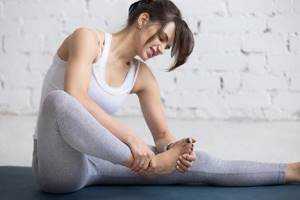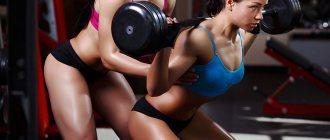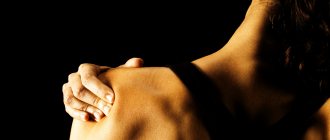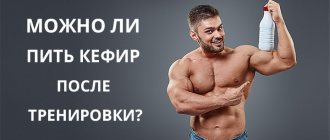Why do muscles hurt after training?
Muscle pain is a consequence of physical activity; it indicates micro-tears in the muscle fibers. This is not something scary, but is a completely natural process. During training under heavy load, muscle fibers, or rather some part of them, are torn.
Without this process, progress is impossible, because it is this process that indicates to the brain that the body does not have enough fibers to do the job. Thus, the hypertrophy mechanism is launched, the brain mobilizes more resources for the construction of new cells. This process is quite natural, but not always useful.
Krepatura is a microtear of muscle fibers, which is felt as an inflammatory process in the muscles and manifests itself along with pain and swelling of the tissue. This process should not be confused with muscle rupture. That is, a muscle rupture is a terrible injury that cannot be cured without surgery, and micro-tears heal on their own in a few days. Of course, there is no need to be afraid, because the rupture occurs due to the work of unprepared muscles. This concept also includes the lack of proper warm-up, as well as the use of large working weights.
No pain - good or bad?
As we have already noted, it all depends on the goals. For example, you want to maintain a certain level of your development, and then you do not need to progress the load. Or you want to lose weight and are training hard. Or you are involved in bodybuilding, and muscle growth is important to you. In all cases you will experience different sensations.
Remember, any progress comes through pain, this requires willpower and perseverance. In a state of comfort, no progress can be made. Not in the gym, not in life. Do you want success? We must overcome ourselves. We need to improve. And for this you need a clear and clear goal.
Goal 1: you keep your body in shape
When you train so as not to gain fat, so that your muscles remain toned for as long as possible, and generally exercise for good health and mood, muscle pain is present only at first.
When you just started training, or returned to it after a break, then your muscles hurt. Then the muscles will adapt (or, to put it in Darwinian language, adapt) to the loads, rebuilding their physiology and biochemistry in a new way in accordance with your lifestyle.
Now, for pain to set in, you need to add one more lap to your morning jog, or a couple extra reps to your pull-ups or dips. One more thing - it must be hard for you. If all the extra reps and circuits come easy to you, you're unlikely to feel any pain.
Your muscular system is accustomed to such training density. The body is maintained in the shape you need. In your case, pain is not needed.
To make it clearer what we mean when we say “keep in shape,” let’s give an example: a person runs 3–5 km every day in the morning. Or goes to the gym twice a week without progressive loads. This accelerates the blood, has a beneficial effect on the body and maintains all its systems in working functional condition.
Goal 2: lose weight
Losing weight is associated with serious aerobic and anaerobic exercise. You need to sweat, you need to give a good workout. At the same time, in order not to overload the heart, it must be dosed correctly.

The muscles will be sore for the first 2-3 weeks. Then, with the same program (and the program will most likely be changed for you), the muscles adapt and no longer hurt.
Goal 3: bodybuilding and strength gains
When you want progress, prepare for pain. To increase muscle strength or size, you need to push yourself to the limit.

At first, when you correctly begin to enter the training regime, your muscles hurt, despite the fact that the weights are not maximum. You will feel like you can still lift the weight. And the pain will still keep you company for 2-3 days after exercise.
The main thing here is not to tear the muscle. It's one thing when you loaded it and caused muscle cell growth. And another thing is when excessive load led to tears.
Be careful. Lacerations take months to heal, sometimes up to six months or more. And they demand that you stop training.
Do your muscles always hurt after training?
Muscles don't always hurt. It is possible that at first pain may occur after each workout, but in the future the body will adapt to the load and the muscles will cope with the work more easily. Also, the athlete’s body stops hurting due to its readiness for rapid regeneration. This is also part of the body’s adaptation, plus proper nutrition, rich in protein, which helps reduce pain, as the process proceeds faster and easier.

Reasons for the absence of pain
- Monotony of exercises and automaticity. Performing the same loads on the same muscle group, for example, the abdominal muscles, can lead to the disappearance of pain. This is due to the body’s adaptation and the cessation of muscle fiber ruptures. Some may advise you (even some super-mega experts) that “ideally, you should do no more than four identical workouts if you want to achieve a positive result.” But still, do not forget that it makes sense to change the training scheme only after it has outlived its usefulness. I already talked about this above.
- Your strength and endurance have increased. This means that you should increase the intensity of training and working weights. You can also try a new sport or develop a new exercise program.
- You are "philoning". If you are not working at the limit of your capabilities, then your efficiency decreases and may even be zero. Therefore, reconsider your attitude towards training. If you lack motivation, you need to increase it. There is an awesome article about this on the topic of motivation.
- Reduced sensitivity threshold. Receptors responsible for sensitivity and sensations of pain stop sending signals to the brain.
- Fast muscle regeneration. This is not a reason to panic. We can simply congratulate you on this.
Should your muscles hurt after every workout?
In fact, soreness is not some kind of sign that the athlete worked fruitfully in training. Rather, it indicates overtraining, although it is generally accepted that muscle pain is a good sign. Microtears may appear in small numbers after a workout, and a person may not feel any pain at all the next day. By the way, most often the peak of pain occurs on the second day after training and is associated with swelling, inflammation and other effects of the post-traumatic period.
Pain pain discord

Muscle pain that occurs after training is usually divided into several types.
- Post-workout moderate pain. Usually the athlete feels it the next day after training. It is especially noticeable when muscles that were loaded yesterday are used. This pain can last up to several days. The reason is clear: as a result of excessive stress, microtraumas (tears) have formed in the muscle tissue, and pain indicates their healing and restoration of their previous integrity.
- Delayed pain. It occurs 2-3 days after training loads. The pain becomes especially noticeable when muscles are stretched or contracted. Usually it happens:
- in overtrained athletes;
- after a long break from training;
- due to changes in the training program;
- for beginner athletes who have just started training.
- Pain as a result of an injury. Here, in principle, everything is clear and without comment. An injury is always accompanied by pain, and it will continue to hurt until the athlete heals the injury.
How to deal with pain after exercise

Please note: it is impossible to completely avoid muscle pain after performing training exercises. One way or another, the pain will still be felt. Another question is what exactly her character is. Pleasant fatigue is one thing, and an unpleasant, sharp, breaking and nagging pain that interferes with movement and causes all sorts of discomfort is quite another thing. Such pain should not be allowed, and if it does occur, it is necessary to fight it. To do this, there are a number of practice-tested and expert-recommended rules.
Let's first tell you how to prevent post-workout pain.
- You should not “break records” during training. There is a time for everything: records are approached gradually, the muscles, and the whole body as a whole must adapt to them. In other words, physical activity should increase gradually when the muscles are ready for it as a result of previous training. But even in this case, you need to know your own physical capabilities, and not load your muscles beyond the limit established by nature. In the end, all sorts of records are not the main thing. Your own health is much more important.
- It is necessary to constantly remember the correct technique for performing this or that exercise. An incorrectly performed exercise is the most common cause of injury, and therefore pain.
- Before starting a workout, a warm-up is a must. Warm muscles have a much lower risk of tearing. In addition to the warm-up, a cool-down is also necessary - a set of recovery exercises. Everything is clear here too. Recovered (and therefore rested) muscles after training will hurt much less.
- You should not exercise at all if you feel very tired or unwell. Both are common causes of stress, and a stressed body does not always adequately cope with physical activity. The result is either injury or torn muscles.
- A prerequisite is compliance with the drinking regime. Water thins the blood; thinned blood supplies the muscles with oxygen and nutrients more easily and quickly. Saturated muscles have a much lower risk of injury.
- Another condition is normal, sufficient sleep. A well-rested person is at much less risk of injury.

But, let’s say, despite all efforts, post-workout pain still occurs. How can I remove them or at least lighten them? There are also certain rules for this.
- Regular massages. They accelerate the blood and ensure the supply of nutrients to various parts of the body, including the muscles. As a result, muscle tears heal faster and the pain goes away.
- Proper nutrition. In this case, it is a sufficient amount of protein. It is he who restores muscle microtraumas resulting from training.
- Complete rest. If pain prevents you from exercising, it is better not to train at all, but to rest for several days until it subsides on its own.
- Pain can be relieved well in the following ways: regular visits to the bathhouse or sauna, hardening, warming ointments.
You shouldn't be afraid of post-workout pain. The main thing is to understand that it is difficult to do without it, and, in addition, to know how to prevent it or alleviate it.
How to minimize pain?
- First of all, the athlete must devote enough time to warming up . The body needs to be properly warmed up. And this should be done before every workout.
- Be sure to start your workout with cardio exercise , such as running, and introduce a complex of joint gymnastics.
- Every strength exercise should begin with a warm-up set consisting of a high number of repetitions. The weight of sports equipment in it should be minimal. If this is a bench press, then you need to start with an empty bar, after which you will need to perform another approach with a light weight, and only then work with the usual weights or increase the load.
- Another important point is the correct execution of exercises . During movements, jerks should not be made, and the range of movements must also be observed. For example, when performing dumbbell flyes, you do not need to lower your hands with dumbbells below the level of the pectoral muscles. Even using a small weight, the fibers stretch very strongly and will certainly break.
- For rapid muscle recovery, a large amount of amino acids is required, so the athlete's diet should be high in protein .











